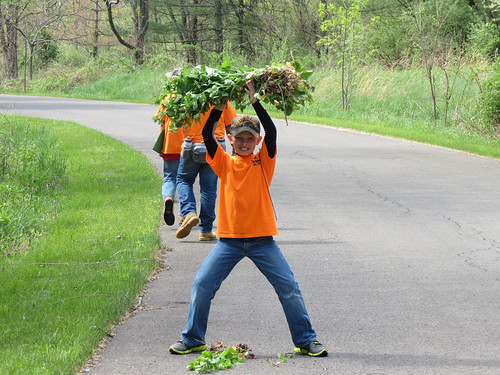
Spring is often associated with ramps, rain, flowers and frogs, but on the Monongahela National Forest, the season of rebirth is focused on protecting our woods from garlic mustard.
Garlic mustard is a non-native invasive plant first brought to America by European settlers in the 1800s. They enjoyed eating it because of its zesty garlic-like flavor. They just had no idea that this plant would become one of the biggest threats to the diversity of plants and animals found in our eastern forests.
In an effort to fight the spread of this invasive species, the Monongahela, along with several partners, hosts an annual Garlic Mustard Challenge to increase public awareness about the threat of non-native invasive species and to achieve boots-on-the-ground results. Last year, elementary school students in Grant County, West Virginia, removed more than 13,000 pounds of garlic mustard from the Monongahela.
Celebrating its sixth year, this spring’s Challenge was a huge success with a current tally of more than 350 volunteers from three states who pulled more than 7,200 pounds of garlic mustard. And the work is ongoing.
“Only an army of volunteers can help get rid of this invasive species and help keep our forests healthy,” said Monongahela ecologist Cynthia Sandeno. “Volunteers are essential to the work that we accomplish in the Forest Service both locally and nationally.”
Garlic mustard is a biennial herb – meaning it takes two years to complete its life cycle. In the first year, the plant grows a rosette of green, kidney-shaped leaves that stay close to the ground. These leaves remain green through the winter and develop into mature plants the following spring. Second year plants grow taller and leaves become more triangular. The leaves have a lot of teeth along the edges and give off a strong odor of garlic when crushed. Second year plants produce button-like clusters of small white flowers. Each flower has four petals in the shape of a cross.
Garlic mustard produces as many as 5,000 seeds per year, which can remain alive in the soil for five to seven years.

“Garlic mustard is a particularly nasty, non-native invasive species that thrives in partial shade and has no trouble growing in forest understories,” Sandeno said. “This species can quickly take over an area, crowding out our beloved native plants, including trillium, orchids, jack-in-the-pulpit, and even tree seedlings.”
Garlic mustard also produces chemicals that can keep native plants from being able to grow. The plant is also harmful to some of our butterflies. The rare West Virginia white butterfly sometimes mistakenly lays its eggs on garlic mustard instead of their native host plants – and the results are disastrous. The eggs hatch, but the caterpillars die.
While the 2014 Garlic Mustard Challenge is winding down, there are still opportunities to get involved. First year plants can be pulled throughout the spring, fall, and even winter. And, once you have pulled some garlic mustard, don’t forget to use it in your cooking. First year leaves are the tastiest and are sure to spice up your lasagna, spaghetti, or pizza. There are hundreds of ways to cook with garlic mustard, many of them available on the Internet.
While garlic mustard rosettes are fairly easy to identify, they are similar to a couple of native species. Here are a few tips on how to identify garlic mustard: Garlic mustard has deeply-toothed edges and many deep veins. Garlic mustard leaves are flattened and papery rather than succulent and garlic mustard rosette leaves smell like garlic when crushed.
Do not forget to check in with the forest office or ranger district before collecting any type of forest products.
Learn about Forest Service volunteer opportunities.
Watch a video about garlic mustard.



